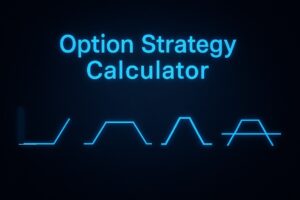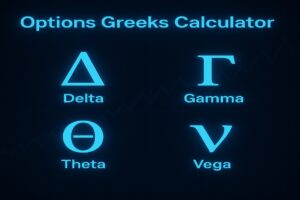
Binomial Option Pricing Model Calculator
Calculate option prices using the binomial option pricing model with this comprehensive binomial option pricing model calculator. Input stock price, strike price, up and down factors, and time parameters to determine theoretical option values for both European and American exercise styles.
Video Tutorial: Binomial Option Pricing Model Explained
Watch this comprehensive tutorial to master the binomial model and learn how to use our calculator effectively for both European and American options.
Price Options with the Binomial Option Pricing Model
The binomial option pricing model, developed by Cox, Ross, and Rubinstein, provides a discrete-time framework for valuing options that serves as an alternative to the Black-Scholes model. This binomial option pricing model calculator allows you to explore how stock price movements through a tree structure can determine fair option values, while providing educational insights into risk-neutral probabilities and implied volatility assumptions.
What This Calculator Provides:
This tool calculates comprehensive binomial option pricing for:
- European Call and Put Options: Standard options that can only be exercised at expiration.
- American Call and Put Options: Options with early exercise features that can be exercised at any time before expiration.
- Implied Volatility Analysis: Shows what annual volatility your up and down factors assume.
- Risk-Neutral Probability: Displays the mathematical probability of upward price movements in the model.
Understanding the binomial model helps traders and students grasp the fundamental mechanics of option pricing, early exercise decisions, and the relationship between volatility and price movement assumptions.
How to Use the Binomial Option Pricing Model Calculator:
- Select Option Type: Choose call option or put option.
- Select Exercise Style: Choose European (exercise at expiration only) or American (early exercise allowed).
- Enter Current Stock Price (S): The current market price of the underlying asset.
- Enter Strike Price (K): The exercise price of the option contract.
- Enter Time to Expiration (Years): The time remaining until option expiration in years.
- Enter Up Factor (u): The multiplier for upward stock price movements (e.g., 1.1 = 10% increase).
- Enter Down Factor (d): The multiplier for downward stock price movements (e.g., 0.9 = 10% decrease).
- Enter Risk-Free Rate (%): The current annualized risk-free rate.
- Enter Time Steps per Year: Higher values increase calculation accuracy (default: 1).
- View Results: The calculator displays the option price, implied volatility, and risk-neutral probability.
Understanding the Binomial Option Pricing Model:
The binomial model breaks down the option’s life into discrete time periods, assuming the stock price can only move up or down by predetermined factors. This approach offers several advantages:
- Intuitive Framework: Easy to visualize stock price movements through a tree structure.
- American Option Handling: Naturally accommodates early exercise decisions at each node.
- Educational Value: Demonstrates the fundamental principles behind all option pricing models.
- Flexibility: Can be adapted for dividends, varying volatility, and complex payoff structures.
- Convergence to Black-Scholes: As time steps increase, results approach Black-Scholes model values.
Key Concepts & Model Parameters:
When using this binomial option pricing model calculator, understand these critical components:
- Up and Down Factors: Determine the magnitude of price movements. Higher up factors and lower down factors imply greater volatility.
- Risk-Neutral Probability: The mathematical probability of upward movements that makes the model arbitrage-free.
- Time Steps: More steps provide greater accuracy but require more computation. Most academic examples use 1-50 steps.
- Early Exercise Premium: American options trade at a premium to European options when early exercise has value.
- Implied Volatility Connection: The relationship between your factors and equivalent implied volatility assumptions.
American vs European Options:
One key advantage of the binomial model is its ability to handle American-style options:
- European Options: Can only be exercised at expiration, making valuation simpler.
- American Options: Allow early exercise, which can be valuable for deep in-the-money puts or dividend-paying stocks.
- Early Exercise Decision: The model compares continuation value versus immediate exercise at each node.
- Premium Calculation: American options typically trade at a premium to their European counterparts.
Educational Applications:
Finance students and professionals use binomial models to understand:
- Option Pricing Fundamentals: Grasp the basic mechanics behind all derivative pricing models.
- Risk-Neutral Valuation: Learn how options are priced using risk-neutral probabilities rather than actual probabilities.
- Early Exercise Strategy: Analyze when American options should be exercised before expiration.
- Parameter Sensitivity: See how changes in volatility assumptions affect option values.
- Model Convergence: Understand how discrete models approach continuous models as time steps increase.
Practical Trading Applications:
Professional traders use binomial analysis for:
- American Option Valuation: Assess early exercise premiums for puts and dividend-capture strategies.
- Educational Benchmarking: Compare binomial results to Black-Scholes pricing for model validation.
- Volatility Analysis: Understand what volatility assumptions different up/down factors represent.
- Risk Management: Analyze how different market scenarios affect option portfolios.
- Strategy Development: Design complex trading strategies based on early exercise probabilities.
This calculator provides both theoretical education and practical option pricing capabilities. While the binomial model uses simplified assumptions about price movements, it offers valuable insights into option behavior and serves as a foundation for understanding more advanced pricing models.
See my preferred options broker IBKR here.
Save on Top Finance Tools & Services
Get exclusive savings on essential CFA prep courses, market data feeds, stock research platforms, brokerage services, and more through our partnerships.


